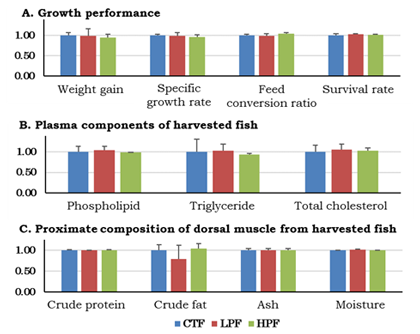Utilization of poultry by-product meal as an effective alternative to fish meal in aquaculture feed for milkfish Chanos chanos
Description
In many cases, aquaculture feeds depend on fish-meal and fish-oil as their protein and fat sources, respectively. They are products of capture fisheries. The recent stagnation in capture fisheries production due to limitations on fisheries resources, has caused a steep rise in the price of fish-meal/fish-oil, and eventually aquaculture feeds, to fulfill increasing demands for aquaculture products. In the case of Philippine milkfish cage culture, feed cost covers three quarters of the total expenses. Thus, reducing feed costs is essential to improve profitability of aquaculture management. We explored possible alternative protein sources that are cheap, effective, and available on site to reduce dependency on fish-meal/fish-oil in producing fish feeds. In the Philippines, we developed low fish-meal feeds for milkfish by utilizing poultry by-products (PBP), which are wastes that are collected after removing the edible parts from poultry.
Replacing the fish-meal with PBP, the experimental feeds were formulated to contain 27% crude protein, 10% crude fat, and 31% crude starch (Table 1). Milkfish juveniles (≈50g) were fed with experimental feeds and grown to market size (≈300g). Among experimental feeds, there were no significant differences in the growth parameters such as weight gain, specific growth rate, feed conversion ratio, and survival rate of the milkfish (one-way ANOVA and Fisher’s PLSD) (Fig. 2A). The plasma components (phospholipids, triacylglycerol, and total cholesterol) of the harvested fish were not significantly affected by the experimental feeds (Fig. 2B). The proximate compositions of dorsal muscle from harvested fish, such as crude protein, crude fat, ash, and moisture, were not significantly different from each other’s (Fig. 2C), and so were those of the whole body and the liver. Regarding the taste of the harvested fish, 48 participants (common people and researchers) did not recognize the differences in terms of smell, taste, and textures of the fish, and whether which of the experimental feeds were fed. These results indicate that the low fish-meal/fish-oil feeds developed using PBP have equivalent effect as commercial feeds on the growth of the juvenile milkfish and the quality of the harvested fish. As a result, we can reduce fish-meal by 75% and fish-oil by 15% if we mix 12% PBP as feed raw material for milkfish aquaculture.
We have also evaluated the versatility of the developed PBP feeds, and noted that it could be utilized effectively not only to milkfish but also to other aquaculture fishes. However, as the proximate compositions of PBP differ a lot, the compound ratio of PBP for the feeds should be adjusted accordingly.
Figure, table
-
Fig. 1. Harvested milkfish (Chanos chanos) 29.8 cm fork length
-
Table 1. Composition of the experimental feeds
The parenthesis indicates reduction rate of fish meal and fish oil.CTF LPF HPF Poultry by product 0% 8% 12% Fish meal 20% 10% (-50%) 5% (-75%) Fish oil 4.45% 4.00% (-10%) 3.78% (-15%)
CTF: Control feed, LPF: Low poultry by-product feed, HPF: High poultry by-product feed -
Fig. 2. Growth performance and quality of harvested milkfish fed with experimental feeds. Relative values when each value at CTF = 1.00. Initial number of experimental fish: 1483±1, Culture period: 84 days, Average water temperature: 28.3±1.2℃
A. Growth performance, B. Plasma components of harvested fish (N=10x2 replicates),
C. Proximate composition of dorsal muscle from harvested fish (N=15x2 replicates)
- Affiliation
-
Japan International Research Center for Agricultural Sciences Fisheries Division
- Classification
-
Technical A
- Research project
- Program name
- Term of research
-
FY2019 (FY2016-FY2020)
- Responsible researcher
-
Sugita Tsuyoshi ( National Research Institute of Fisheries and Environment of Inland Sea )
Gavile Amafe Belleza ( Southeast Asian Fisheries Development Center )
- ほか
- Publication, etc.
-
Sugita T et al. (2020) Japan Agricultural Research Quarterly, 54(3) (in press)
- Japanese PDF
-
2019_C07_A4_ja.pdf507.76 KB
2019_C07_A3_ja.pdf168.21 KB
- English PDF
-
2019_C07_A4_en.pdf159.48 KB
2019_C07_A3_en.pdf211.77 KB
- Poster PDF
-
2019_C07_poster_fin.pdf294.88 KB

![Fig. 1. Harvested milkfish (Chanos chanos) 29.8 cm fork length","title":"Fig. 1. Harvested milkfish (Chanos chanos) 29.8 cm fork length","class":"media-element file-wysiwyg","data-delta":"3"}}]]Fig. 1. Harvested "Fig. 1. Harvested milkfish (Chanos chanos) 29.8 cm fork length","title":"Fig. 1. Harvested milkfish (Chanos chanos) 29.8 cm fork length","class":"media-element file-wysiwyg","data-delta":"3"}}]]Fig. 1. Harvested"](/sites/default/files/202005/2019_C07_fig01_en.png)
